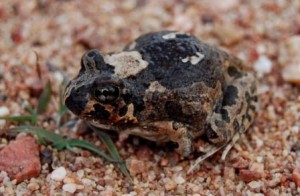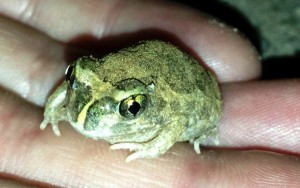This project examines the relationship between frog species and environmental factors which act at different scales, in the mid and lower Lachlan Catchment. Thus, engineering an improved understanding of frog responses to environmental factors at landscape and local scales, in this case, the semi-arid ecosystems of the Lachlan Catchment. These include site hydrology and spatial layout of aquatic habitats, vegetation, water quality and other aquatic organisms. The importance of environmental flow upon breeding and calling, and frogs use of microhabitats, will also be investigated. This will help identify occupancy patterns of frog species as well as what drives breeding responses on local and landscape scales. Understanding these processes will provide important information for future management decisions.
Outcomes
This study is the first large-scale, comprehensive assessment of frog communities and their habitat associations or requirements in the mid and lower Lachlan since the breaking of the Millennium Drought (circa 2010). As information on the distribution of frog species in the Lachlan is limited, the study will address some knowledge gaps which will inform adaptive management by:
- providing an assessment of the current status of frog communities in the study region of the Lachlan Catchment (i.e. community composition, species richness and distribution);
- identifying what species persisted in the region through the drought, and the key aquatic habitats they are now occupying (i.e. collect biophysical and abiotic data, including hydrology, and assess relationship with status of frog communities or 1. above);
- identify, assess and discuss important variables (including the role of environmental water in site hydrology) related to frog occupany patterns in the mid to lower Lachlan; and
- potentially use similar studies conducted in the Murrumbidgee Catchment by other members in the research team to inform discussion of previous outcomes.
In summary, outcomes from the project will inform stakeholder understanding of what conditions best aid frog survival, breeding and dispersal to ultimately improve management decisions and environmental water delivery in the future (with particular reference to managing for specific frog communities).
Progress

During September 2012 and April 2013, 49 sites located between the Great Cumbung Swamp and north of Condobolin in the mid and lower Lachlan Catchment were surveyed on four occasions. Ten frog species were identified, including the endangered Southern Bell Frog (Litoria raniformis; EPBC Act 1999).
Four dominant species were present across all wetland types and differences in the frog communities were driven by rarer species, such as Sudell’s Frog (Neobatrachus sudelli), Green Tree Frog (Litoria caerulea) and Southern Bell Frog. Preliminary assessment of data collated thus far indicates wetlands with hydroperiods of 7-13 months supported the highest diversity of frogs. Non- perennial creeks also supported diverse frog communities and should be considered as important frog habitat in conservation planning.
